IGCSE Physics Past Years Exam Questions: Forces and Motion 2023-24
We analysed the International GCSE past papers and grouped the questions by topic. Here, you will find questions relating to the topic – Forces and motion. Use these to familiarise, practice and prepare for your IGCSE Physics examination.
For more past years exam questions on Forces and Motion see below:
What you need to know
Use the list below as a quick recap for what you need to know before attempting the past year exam questions under this topic. This is based on Edexcel International GCSE in Physics (4PH1) specification with first teaching Sept 2017 and first examination June 2019.
Paper 1 and 2: (1) Forces and motion
Paper 1 covers the all the topics below except where marked “Paper 2 only”. Paper 2 covers all topics.
A. Units
- kilogram (kg), metre (m), metre/second (m/s), metre/second2 (m/s2), newton (N), second (s) and newton/kilogram (N/kg)
- newton metre (Nm), kilogram metre/second (kg m/s)
B. Movement and position
- be able to plot and explain distance-time graphs
- the relationship between average speed, distance and time. average speed = distance moved / time taken
- practical: investigate motion of everyday objects such as toy cars or tennis balls
- the relationship between acceleration, change in velocity over time taken. a = (v − u)/ t
- plot and explain velocity-time graphs, use them to calculate acceleration (gradient) and distance travelled (area under line)
- the relationship between final speed, initial speed, acceleration and distance moved. v2 =u2 +(2×a×s)
C. Forces, movement, shape and momentum
- describe the effects of forces that act on bodies.
- identify different types of forces. (gravitational or electrostatic)
- difference between vector quantities and scalar quantities.
- force is a vector quantity.
- be able to calculate resultant force that act along a line.
- know that friction is a force that opposes motion.
- relationship between unbalanced force, mass and acceleration. F=m×a
- relationship between weight, mass and gravitational field strength. W=m×g
- stopping distance of a car is the sum of thinking and braking distances
- describe the factors that affect stopping distance (speed, mass, road condition, reaction time)
- describe the forces that act on falling objects
- explain why a falling object reaches terminal velocity
- practical: investing how extension varies with applied force for helical springs, metal wires and rubber bands
- Hooke’s Law and elastic behaviour. (ability to recover its original shape)
(Paper 2 Only)
- the relationship between momentum, mass and velocity. p=m×v
- use the idea of momentum to explain safety features
- use the conservation of momentum to calculate mass, velocity and momentum
- the relationship between force, change in momentum and time taken. F = (mv − mu)/ t
- Newton’s Third Law
- Moment = force x perpendicular distance from the pivot
- weight of an object acts through its centre of gravity
- use principle of moments to analyse the parallel forces acting in one plane
- how upward forces on a light beam, supported at its ends, vary with the position of a heavy object placed on the beam.
January 2023 Paper 1P Q1
1. A material is stretched by applying an increasing load. The material shows elastic behaviour as it is stretched.
(a) Describe what is meant by elastic behaviour. (2)
(b) The material obeys Hooke’s law.
Sketch a graph for this material to show that it obeys Hooke’s law as it is stretched.
You should label both axes with appropriate physical quantities. (3)
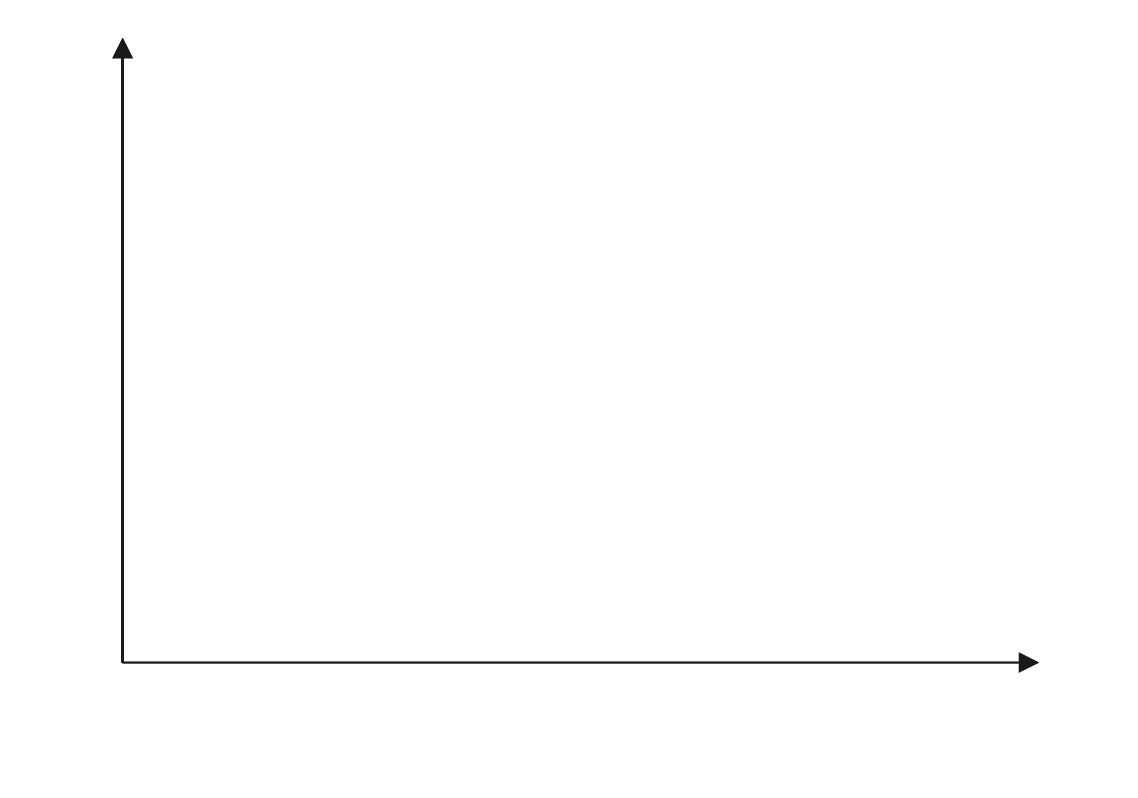
(Total for Question 1 = 5 marks)
January 2023 Paper 1P Q5
5. The graph shows how the thinking distance and the braking distance vary with the speed of a car.
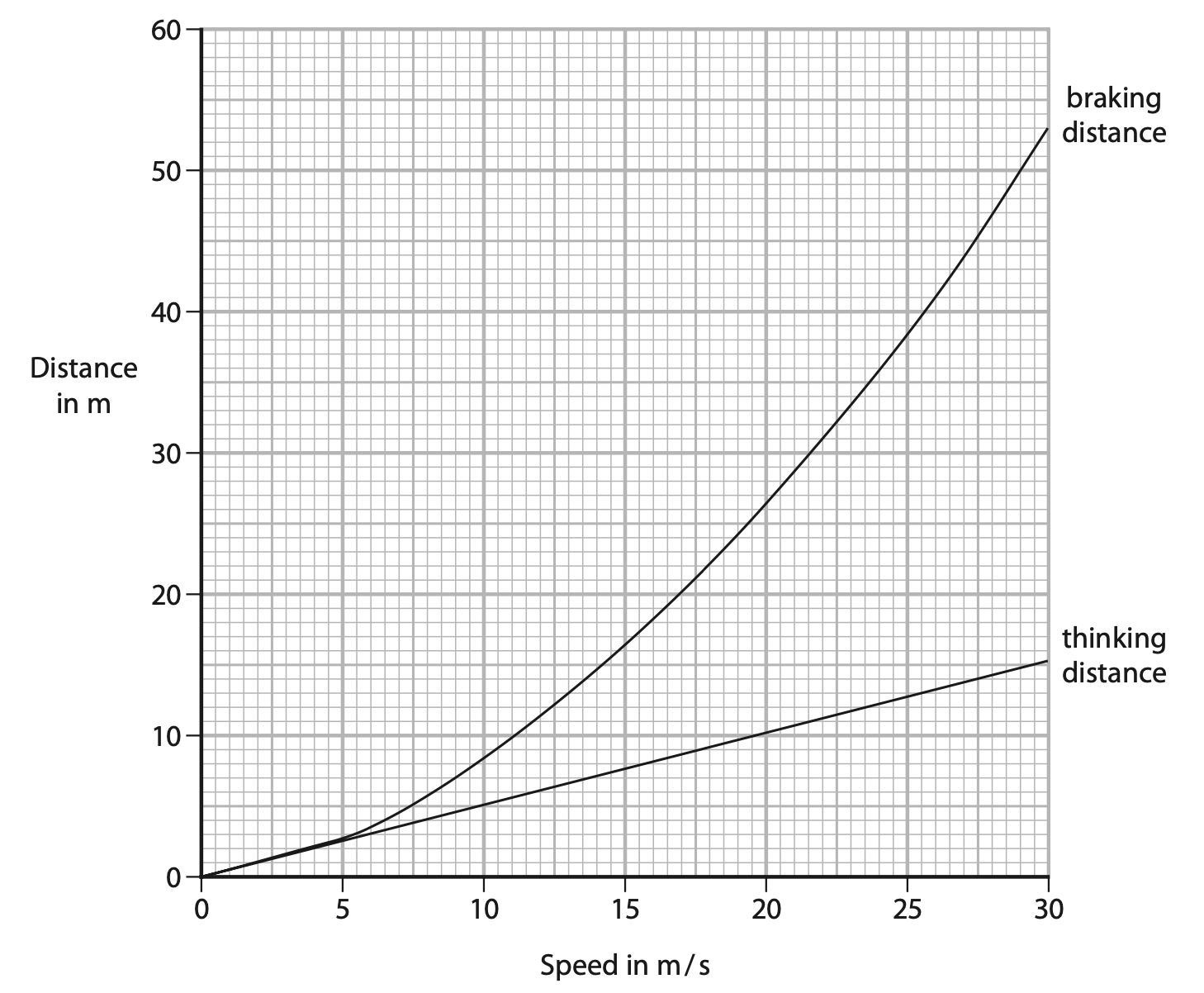
(a) Which of these does not affect thinking distance? (1)
A alcohol consumed by the driver
B condition of the road
C speed of the car
D tiredness of the driver
(b) Which of these would increase the braking distance of the car? (1)
A faster reaction time of driver
B ice on the road
C more powerful brakes
D tyres with more grip
(c) Determine the stopping distance of the car when the speed of the car is 20 m / s. (3)
stopping distance = …………………………………………………….. m
(d) (i) State the formula linking average speed, distance moved and time taken. (1)
(ii) Determine the reaction time of the driver of the car. (3)
reaction time = …………………………………………………….. s
(e) Calculate the mean braking acceleration of the car as it brakes to a stop from an initial speed of 30 m / s. (4)
acceleration = …………………………………………………….. m/s2
(Total for Question 5 = 13 marks)
January 2023 Paper 1PR Q3
3 The diagram shows a balloon with a mass attached held at rest just below the surface of a deep pool of water.
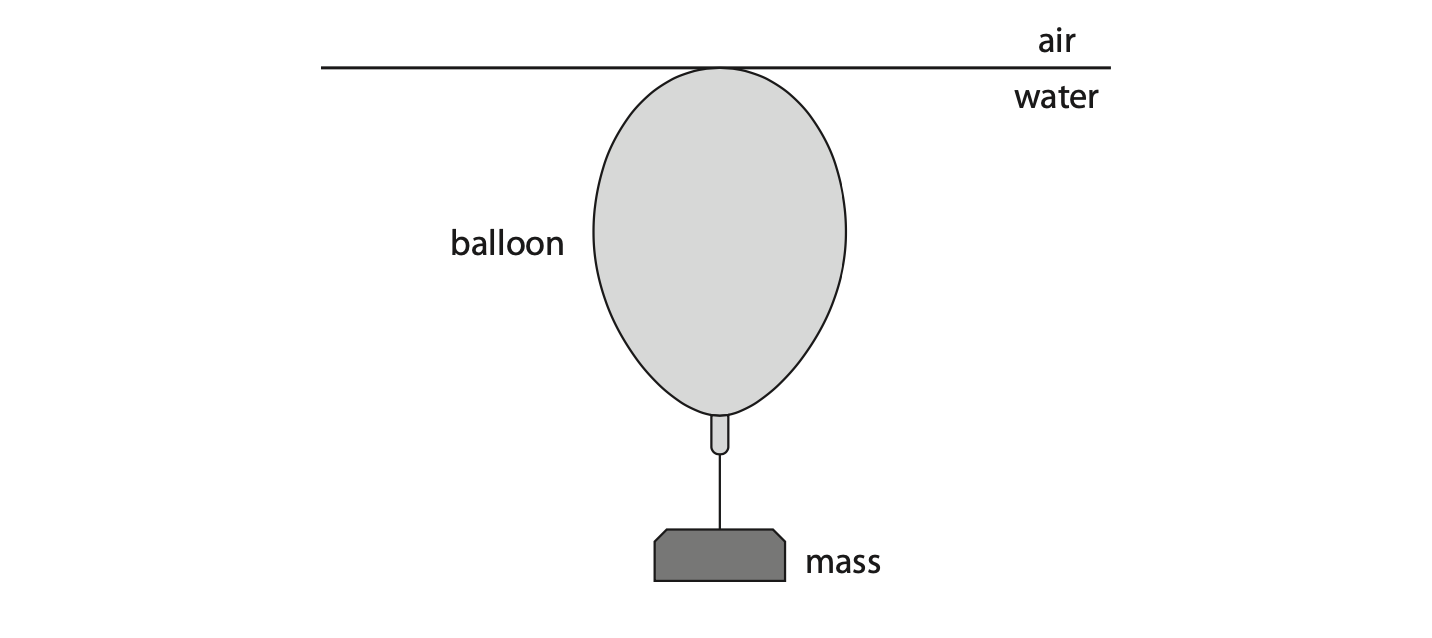
(a) The balloon and mass are released.
The graph shows the velocity-time graph for the balloon and mass as they fall through the water.
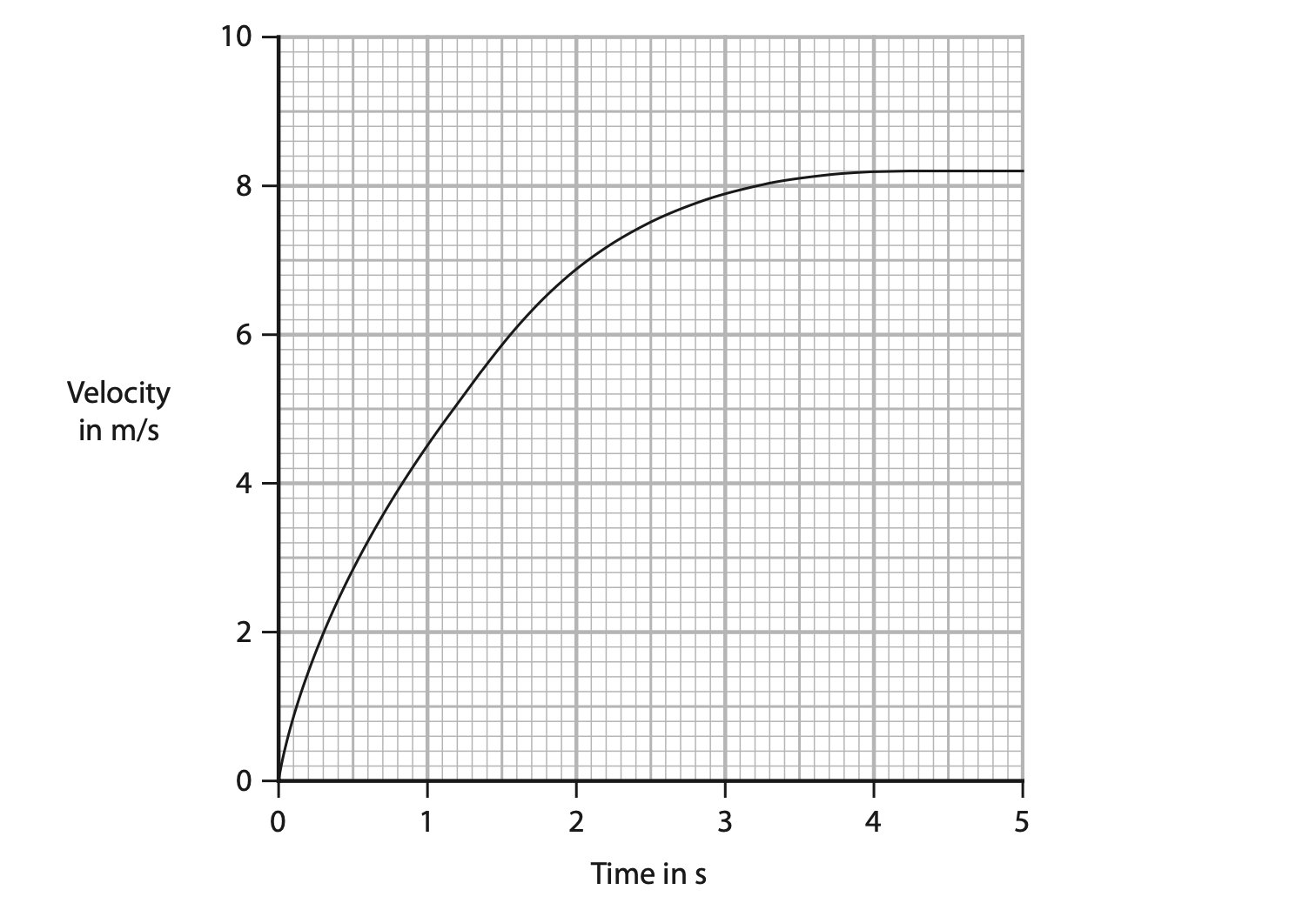
(i) Use information from the graph to determine the terminal velocity of the balloon and mass. (1)
terminal velocity = …………………………………………………….. m/s
(ii) Explain how the balloon reaches terminal velocity.
You should use ideas about forces acting on the balloon in your answer. (3)
(b) (i) State the formula linking pressure difference, height, density and gravitational field strength. (1)
(ii) Calculate the increase in pressure on the balloon when it has reached a depth of 25 m in the water. (2)
[for water, density = 1000 kg/m3]
pressure increase = …………………………………………………….. Pa
(iii) At the surface, the atmospheric pressure on the balloon is 1.0 × 105 Pa.
Show that the total pressure on the balloon at a depth of 25 m is 3.5 × 105 Pa. (1)
(iv) At the surface, where the pressure is 1.0 × 105 Pa, the balloon has a volume of 0.46 m3.
Calculate the volume of the balloon at a depth of 25 m. (3)
volume = …………………………………………………….. m3
(Total for Question 3 = 11 marks)
January 2023 Paper 1PR Q10
10. The diagram shows the forces acting on a firework at take-off.
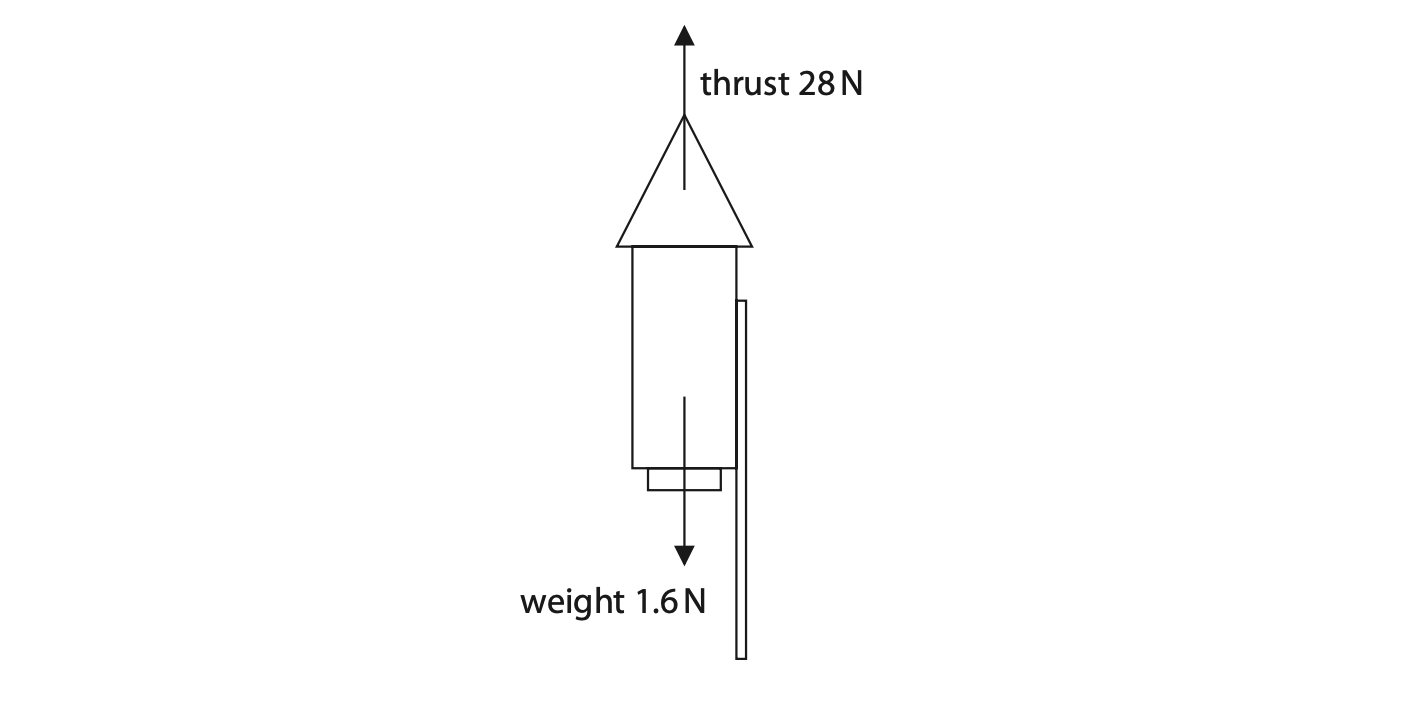
(a) (i) Calculate the magnitude of the resultant force on the firework. (1)
magnitude of resultant force = …………………………………………………….. N
(ii) State the formula linking resultant force, mass and acceleration. (1)
(iii) The mass of the firework is 160 g.
Calculate the acceleration of the firework. (3)
acceleration = …………………………………………………….. m/s2
(iv) Explain how the acceleration of the firework changes between take-off and running out of fuel.
You can assume that the thrust force stays the same as the firework burns the fuel. (3)
(b) The firework makes a sound with constant frequency.
As the firework moves upwards, people on the ground notice that the frequency of the sound they hear changes.
This is called the Doppler effect.
Explain how the Doppler effect causes the observed frequency of sound to change for the people on the ground. (4)
(Total for Question 10 = 12 marks)
January 2023 Paper 2P Q4
4 A squash ball is made of rubber and used to play a game called squash.

A student observes that the squash ball bounces higher after its temperature increases.
The student designs an investigation to see how the temperature of the ball affects the maximum height after it bounces.
(a) State the independent and dependent variables in the student’s investigation. (2)
independent variable:
dependent variable:
(b) The diagram shows the ball at its maximum height after it bounces.
Determine the distance the ball moves from the floor to its maximum height.
Assume the ball does not change shape when it bounces. [1 cm on diagram = 4 cm in laboratory] (2)
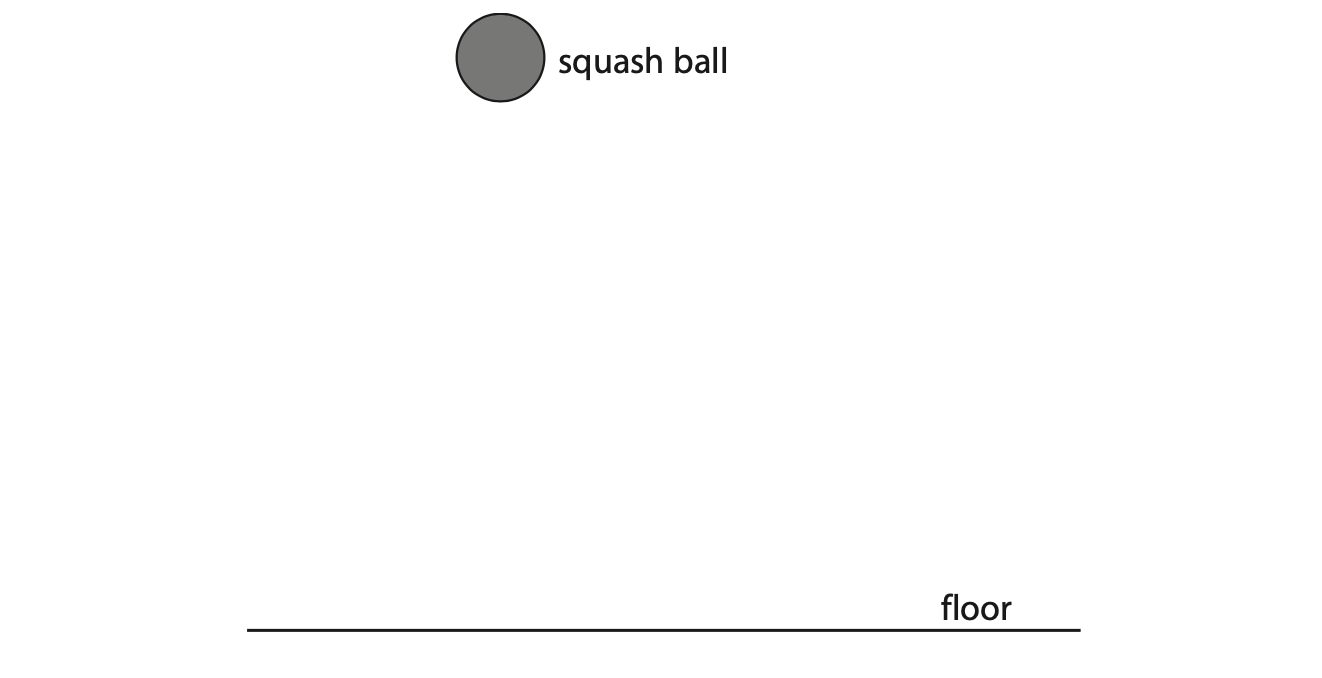
distance = …………………………………………………….. cm
(c) Design a method that the student could use to investigate how the temperature of the ball affects the maximum height after it bounces.
Your answer should include details of
- apparatus needed
- measurements required
- control variables
You may draw a diagram to support your answer. (6)
(Total for Question 4 = 10 marks)
January 2023 Paper 2P Q5
5 Diagram 1 shows a wooden plank balanced horizontally on two supports, A and B.
A block is suspended from the plank between the supports by a cable of negligible weight.
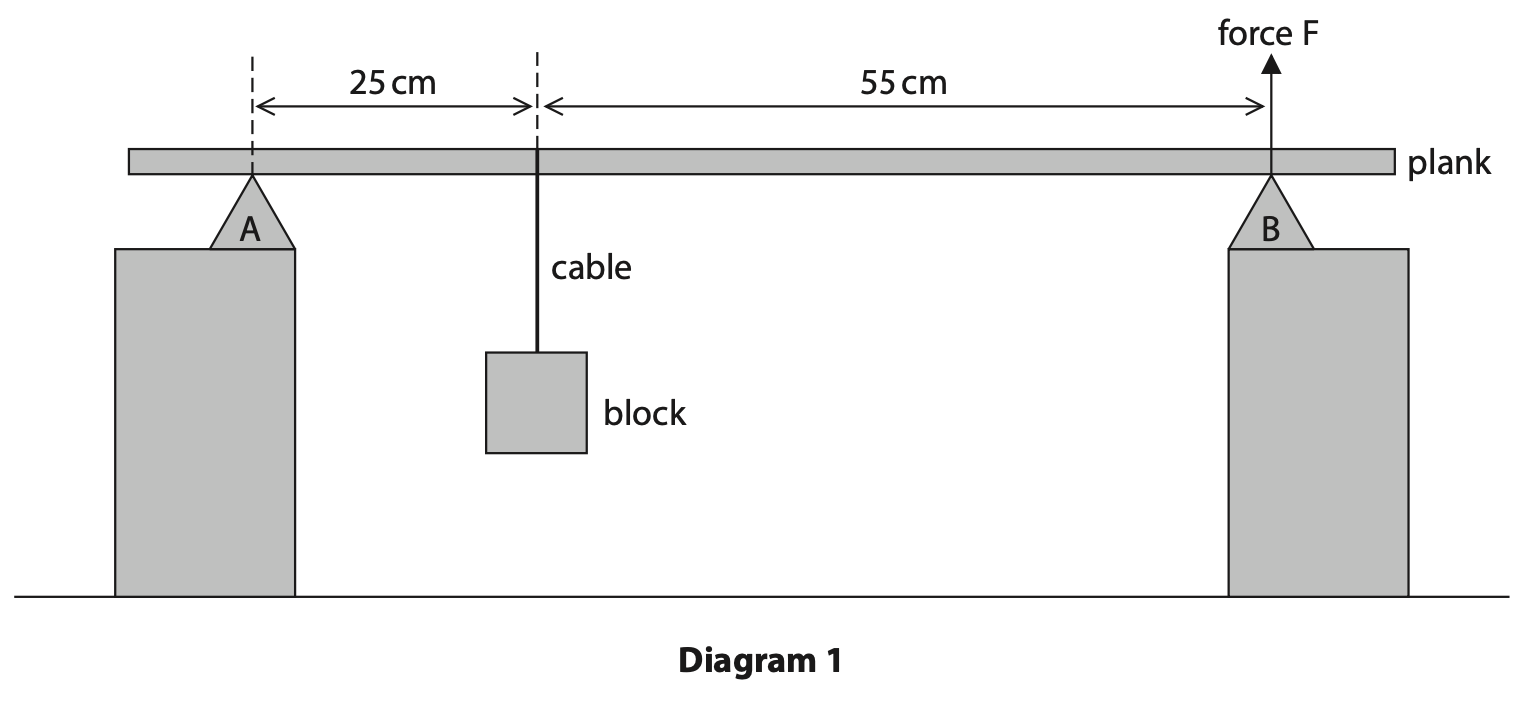
(a) The weight of the block is 260 N.
(i) State the formula linking moment, force and perpendicular distance from the pivot. (1)
(ii) By taking moments about support A, calculate force F. Assume the weight of the plank is negligible. (3)
Force F = …………………………………………………….. N
(iii) Explain what will happen to the magnitude of force F if the block is moved towards support B. (3)
(b) Diagram 2 shows the block and the cable connecting the block to the plank.
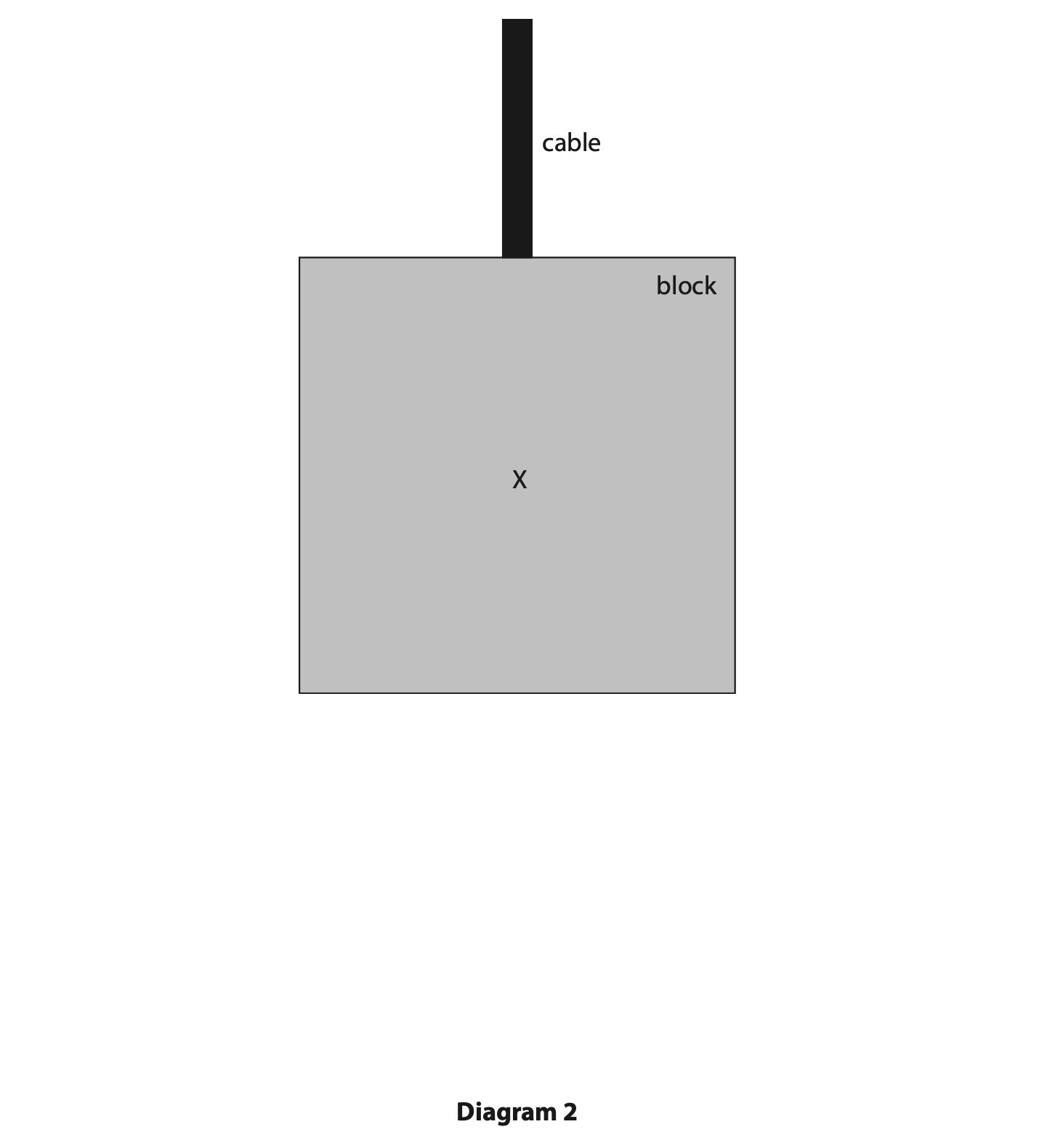
(i) The centre of gravity of the block is located at point X.
Draw an arrow on diagram 2 to show the weight of the block. (2)
(ii) The block also experiences a force due to the tension in the cable.
Explain why the block remains stationary when it is supported by this tension force. (2)
(iii) Explain why the forces acting on the block are not an example of Newton’s third law of motion. (2)
(Total for Question 5 = 13 marks)
January 2023 Paper 2PR Q3
A tumble dryer is a household device that dries clothes. The clothes rotate in a heated cylinder.
Clothes often stick together when they are dry because they become electrostatically charged.
A student investigates how different materials charge electrostatically in a model tumble dryer.
The diagram shows the model tumble dryer.

This is the student’s method.
- put four dry squares of the same material into the cylinder
- rotate the cylinder at constant speed for three minutes
- remove any squares that are stuck together
- measure the force needed to pull the squares apart
- repeat this for squares of different material
(a) (i) Name a device the student could use to measure a force. (1)
(ii) State the independent and dependent variables in this investigation. (2)
Independent:
Dependent:
(iii) State a control variable in this investigation. (1)
(b) Explain how the squares of material stick together. Use ideas about electrostatic charge in your answer. (3)
(c) The table shows some of the student’s results.
| Material | Mean force to separate squares in N |
| wool | 5.4 |
| polyester | 3.2 |
| acrylic | 6.5 |
Explain which type of graph is the most appropriate to present the results from this investigation. (2)
(d) (i) State the formula linking charge, current and time. (1)
(ii) When the squares of material are pulled apart there is a small spark. There is a current of 4.3×10–6 A in the air for a time of 2.3×10–3 s. Calculate the charge that is transferred. (2)
charge = …………………………………………………….. C
(Total for Question 3 = 12 marks)
January 2023 Paper 2PR Q7
A crumple zone is a safety feature in a car.
It is a part of the car that is designed to collapse during a collision.
A student investigates the effectiveness of crumple zones.
The student rolls two model cars down a ramp.
Each car comes to rest when it hits a large metal block.
A data logger measures the mean force applied to the car during the collision with the block.
The diagram shows the equipment used in the investigation.

Car 1 has a paper crumple zone at the front.
Car 2 has no paper crumple zone.
The table shows the student’s results.
| Car | Mean force on car from block in N | Velocity just before car hits block in m/s |
| 1 | 2.5 | 3.0 |
| 2 | 4.9 | 3.0 |
(a) The mass of each car is 0.074 kg.
Calculate the time taken for the velocity of car 1 to decrease from 3.0 m/s to 0.0 m/s. (3)
(b) State the magnitude and direction of the force on the metal block, when car 2 collides with the block. (2)
magnitude = …………………………………………………….. N
direction = ……………………………………………………..
(c) Explain why the mean force from the block on car 1 is smaller than the mean force on car 2. (2)
(Total for Question 7 = 7 marks)
June 2023 Paper 1P Q5
5 The drawing shows a camel and a person in a desert.
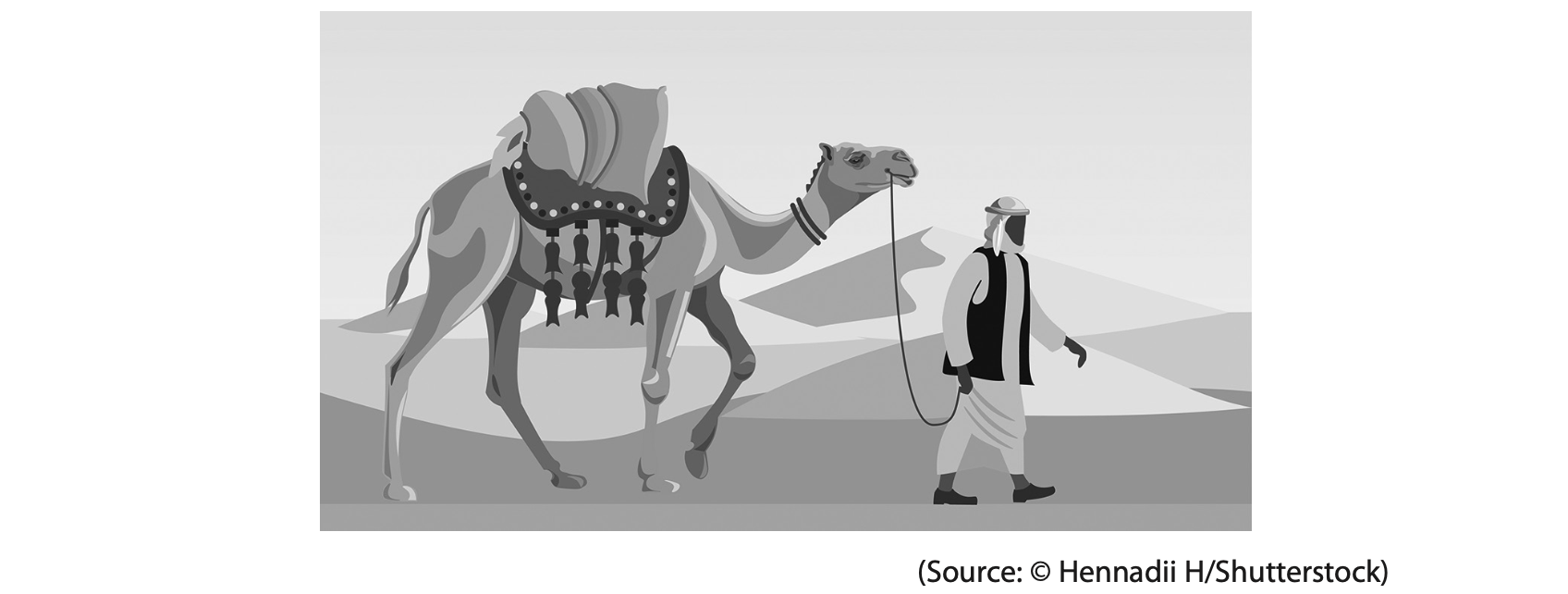
(a) Describe a method you could use to find the pressure a person exerts on the ground when standing on two feet. (4)
(b) The total area of contact of the camel’s feet with the ground is 1300 cm2. The mass of the camel is 660 kg.
Calculate the pressure this camel exerts on the ground. (3)
pressure = …………………………………………………….. N/cm2
(Total for Question 5 = 7 marks)
June 2023 Paper 1P Q5
10 A student investigates how the time taken for a ball to roll down a slope changes with the distance from the bottom of the slope.
This is the student’s method.
- place a ball on the slope 10 cm from the bottom of the slope
- release the ball and start a stopwatch
- stop the stopwatch when the ball arrives at the bottom of the slope
- record the time taken for the ball to roll down the slope
- repeat for different distances from the bottom of the slope
(a) Complete the table by placing a tick (/) to show which variables are the independent, dependent and control variables in this investigation. (4)
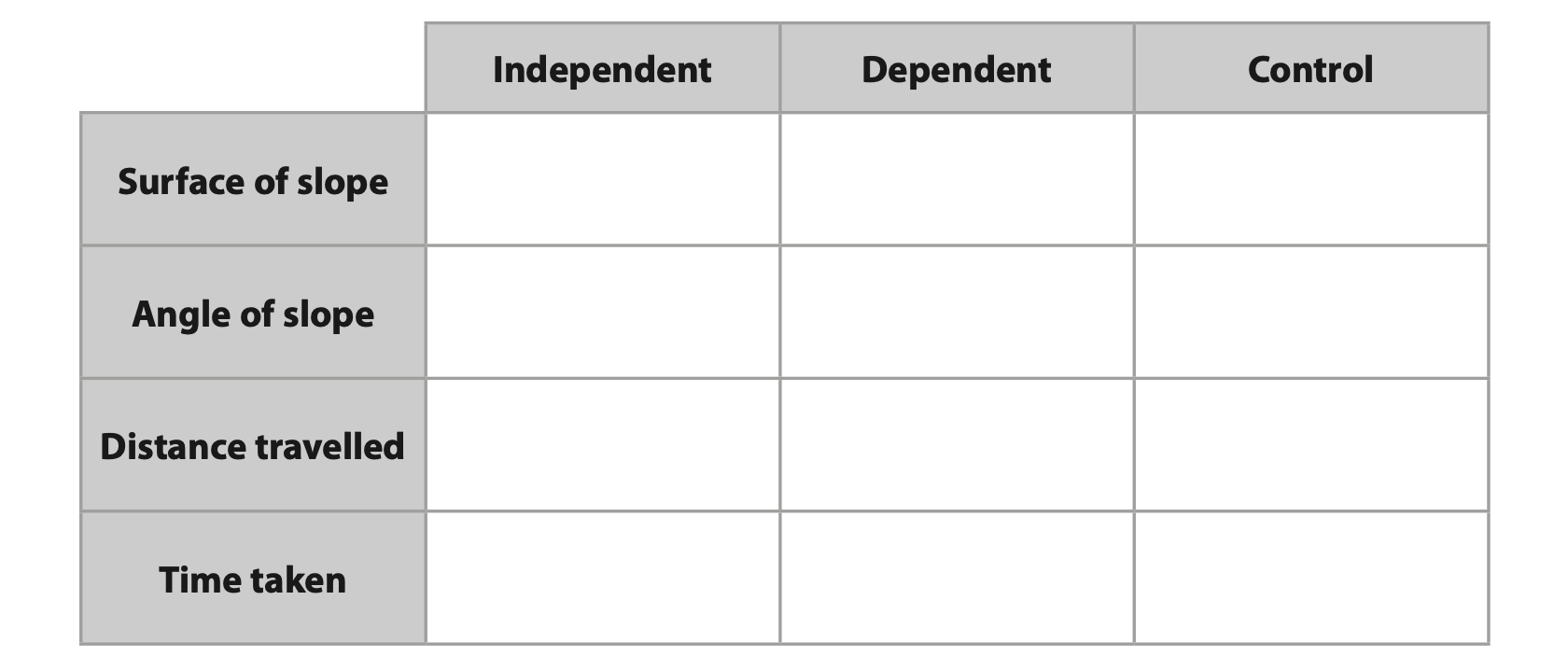
(b) The table shows the student’s results.
| Distance travelled in cm | Time taken in s |
| 10 | 0.41 |
| 20 | 0.58 |
| 30 | 0.71 |
| 40 | 0.82 |
| 50 | 0.91 |
(i) Plot the student’s data on the grid. (1)
(ii) Draw a best fit curve. (1)
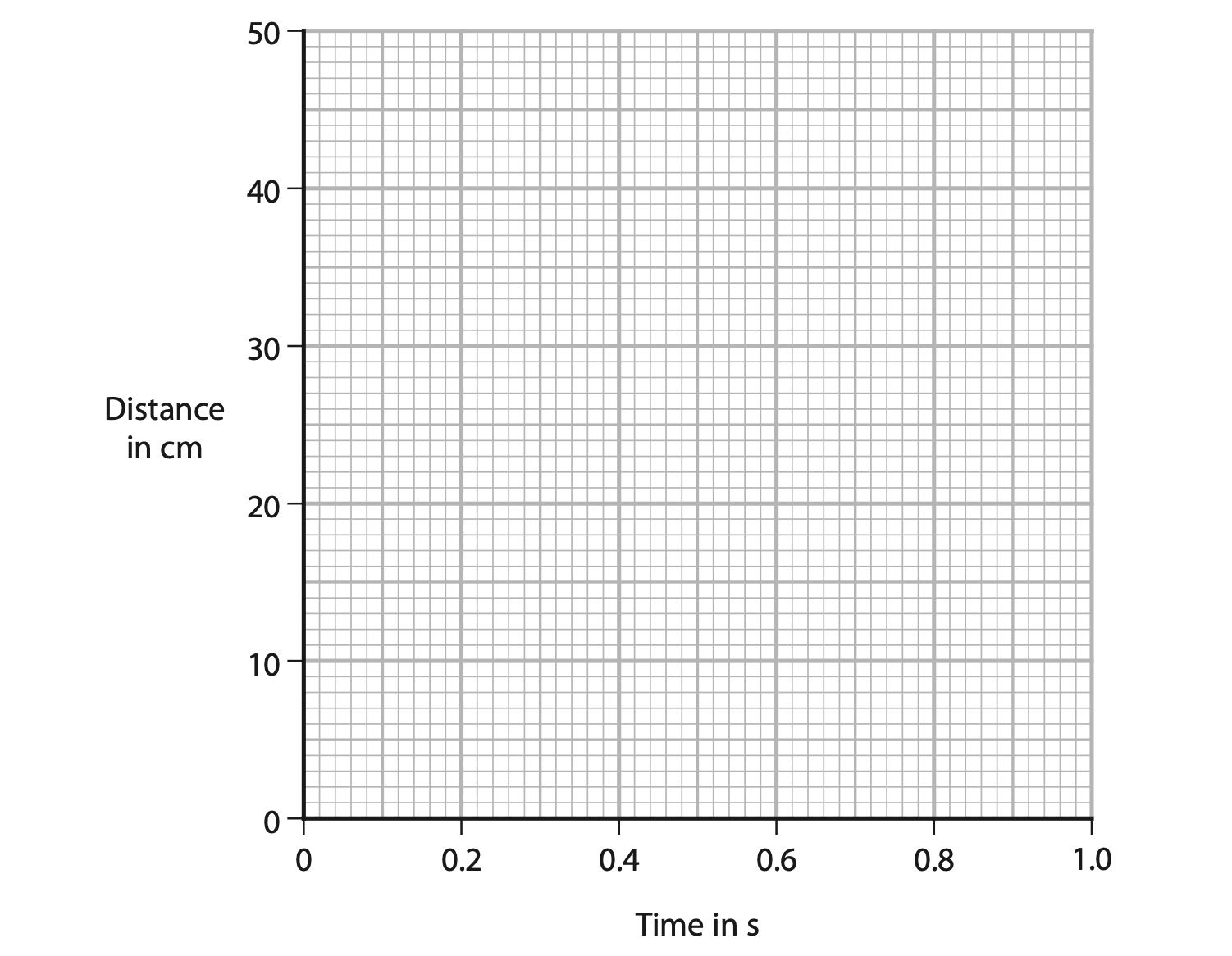
(iii) The student concludes that the results obey this relationship
distance ÷ (time2) = constant
Use the student’s data to deduce whether the student’s results support this conclusion. (4)
(Total for Question 10 = 10 marks)
June 2023 Paper 1PR Q8
8 Diagram 1 shows a set of masses attached to a spring, which is suspended from a support.

(a) After the masses are added, the length of the spring is 14.6 cm. The student measures the extension of the spring as 11.5 cm.
(i) Calculate the original length of the spring. (1)
original length = …………………………………………………….. cm
(ii) The student removes the masses and notices that the spring does not show elastic behaviour.
Predict a value for the new length of the spring after the masses have been removed. (1)
new length of spring = …………………………………………………….. cm
(b) The student puts the masses back on the spring.
The student then pulls the masses down and releases them.
The masses vibrate up and down in a vertical direction, as shown in diagram 2.
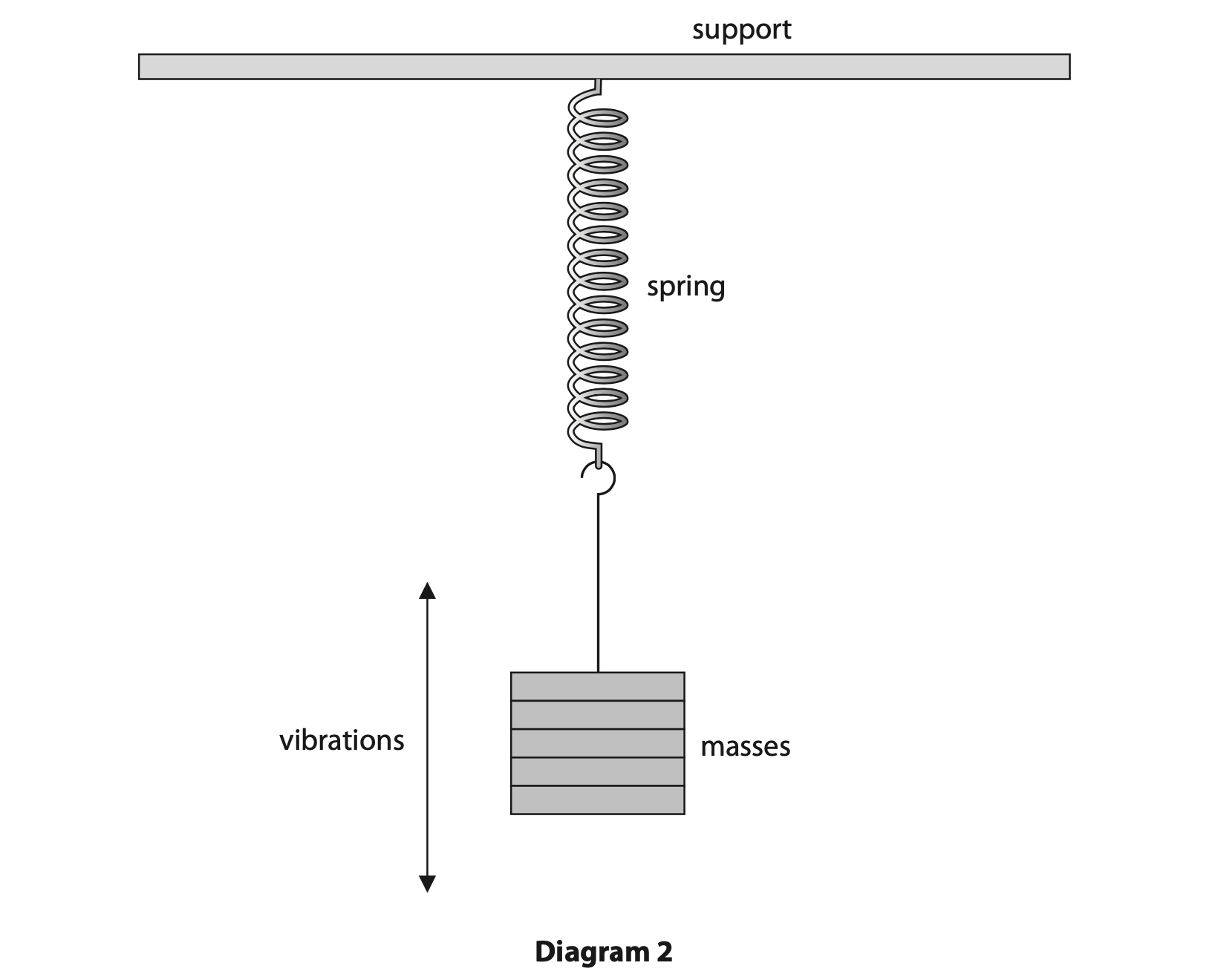
The distance–time graph shows how the distance between the top of the masses and the support changes with time as the masses vibrate.
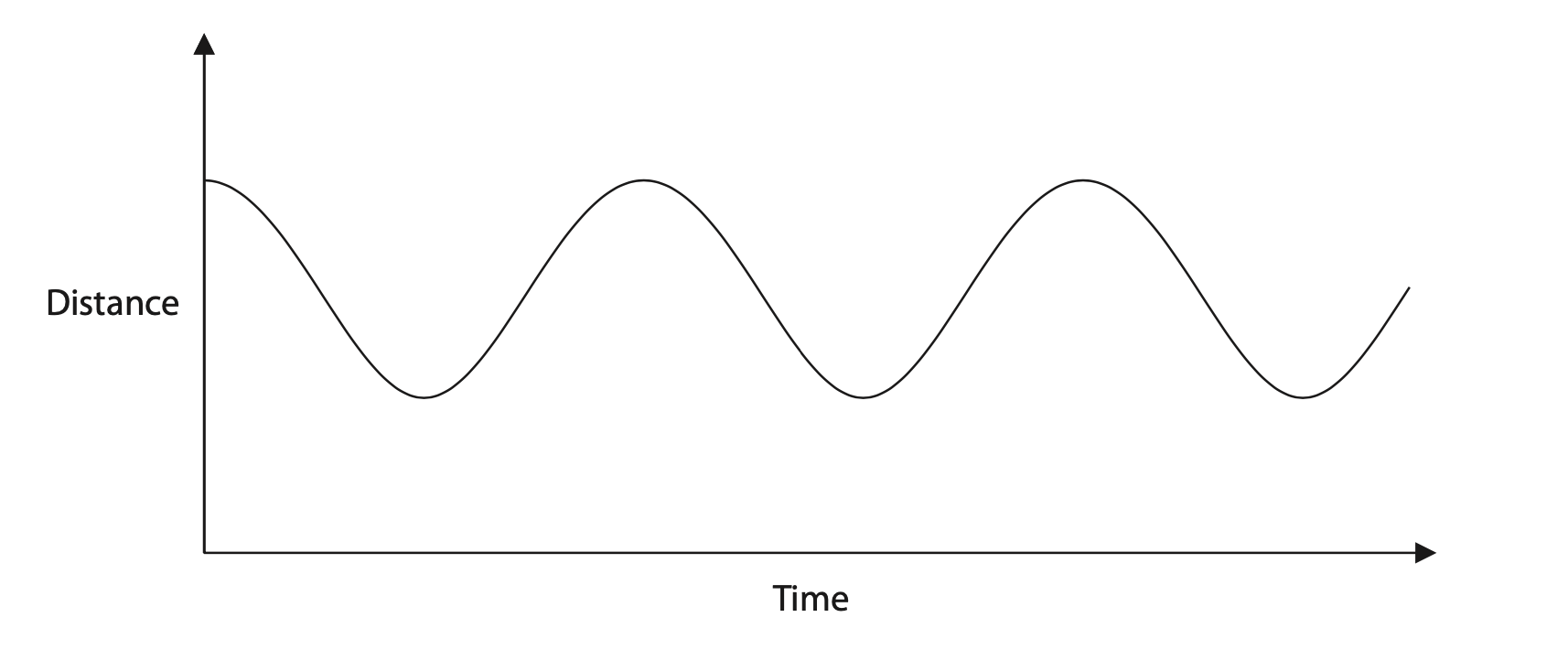
(i) Explain how the gradient of the graph shows that the masses accelerate as they vibrate. (3)
(ii) Add crosses (X) to the distance–time graph to show all the times when the masses are not moving. (2)
(Total for Question 8 = 7 marks)
June 2023 Paper 1PR Q9
9 The driver of a racing car makes a pit stop during a race to change the tyres on the racing car.
The area where the tyres are changed is called the pit lane.

(a) Before entering the pit lane, the speed of the car must decrease for safety reasons.
(i) The mass of the racing car is 830 kg.
The maximum braking force is 41 000 N.
Show that the maximum deceleration of the racing car is approximately 50 m / s2. (3)
(ii) The racing car is travelling at an initial speed of 72 m / s.
Calculate the minimum distance needed to decrease the speed of the racing car from 72m/s to 26m/s. (3)
distance = …………………………………………………….. m
(b) The racing car slows down using its brakes.
The brakes work using friction.
The brakes become very hot when the racing car slows down.
Using ideas about energy, explain why the brakes become hot. (3)
(c) The tyres of the racing car also get very hot during a race.
A mechanic has to handle the hot tyres during the pit stop.
They wear protective gloves which have several layers of insulating materials.
Explain how the layers of insulating materials in the gloves reduce the risk of the mechanic burning their hands on the hot tyres. (2)
(Total for Question 9 = 11 marks)
June 2023 Paper 1PR Q11
11 The gravitational field strength of a planet decreases with increasing distance from the planet.
The table shows the value of the gravitational field strength of Mars at different distances from the centre of Mars.
| Distance from centre of Mars in km | Gravitational field strength in N / kg |
| 4000 | 2.66 |
| 5000 | 1.70 |
| 6000 | 1.18 |
| 7000 | 0.87 |
| 8000 | 0.67 |
| 9000 | 0.53 |
(a) A student finds this formula in a textbook, which links distance from the centre of a planet to its gravitational field strength
gravitational field strength × distance2 = constant
Use data from the table to justify this formula. (4)
(b) Olympus Mons is the tallest mountain on Mars.
The distance between the centre of Mars and the peak of Olympus Mons is 3410 km.
Calculate the gravitational field strength at the peak of Olympus Mons. (3)
gravitational field strength = …………………………………………………….. N/kg
(Total for Question 11 = 7 marks)
June 2023 Paper 2P Q1
Topic: Moments and force balance
A pencil has a weight of 0.16 N.
(a) What is the mass of the pencil?
A 1.6g
B 16g
C 160g
D 1600g
(b) The diagram shows the pencil with one end resting on a small block.

A finger provides an upwards force, F, to keep the pencil horizontal.
(i) The weight of the pencil is 0.16 N.
Calculate the moment of the weight of the pencil about the pivot. (2)
Use the formula
moment = force × perpendicular distance from the pivot
moment = …………………………………………………….. Ncm
(ii) State the moment of the force F. (1)
moment = …………………………………………………….. Ncm
(iii) Show that force F is 0.080 N. (2)
(Total for Question 1 = 6 marks)
June 2023 Paper 2P Q4
4 The diagram shows two birds, just before bird X catches the smaller bird Y.
Both birds are travelling horizontally at constant velocity.
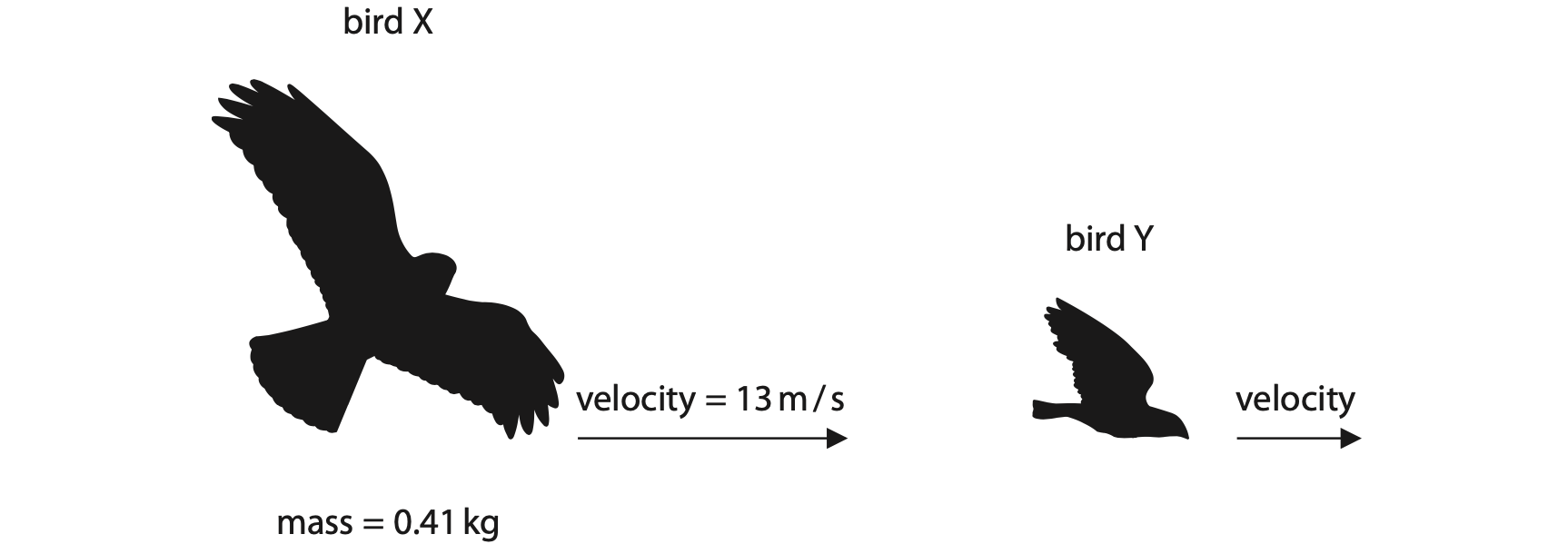
(a) Show that the momentum of bird X is about 5 kg m / s. (2)
(b) The momentum of bird Y just before it is caught is 0.15 kg m / s.
Calculate the total momentum of the birds just before bird X catches bird Y. (1)
momentum = …………………………………………………….. kg m/s
(c) State the total momentum of the birds just after bird X has caught bird Y. (1)
momentum = …………………………………………………….. kg m/s
(d) Bird Y has a mass of 0.17 kg.
Calculate the velocity of the birds just after bird X has caught bird Y. (3)
velocity = …………………………………………………….. m/s
(Total for Question 4 = 7 marks)
June 2023 Paper 2PR Q1
1 (a) The boxes show some physical quantities and their units.
Draw a straight line from each physical quantity to its correct unit.
One has been done for you. (3)
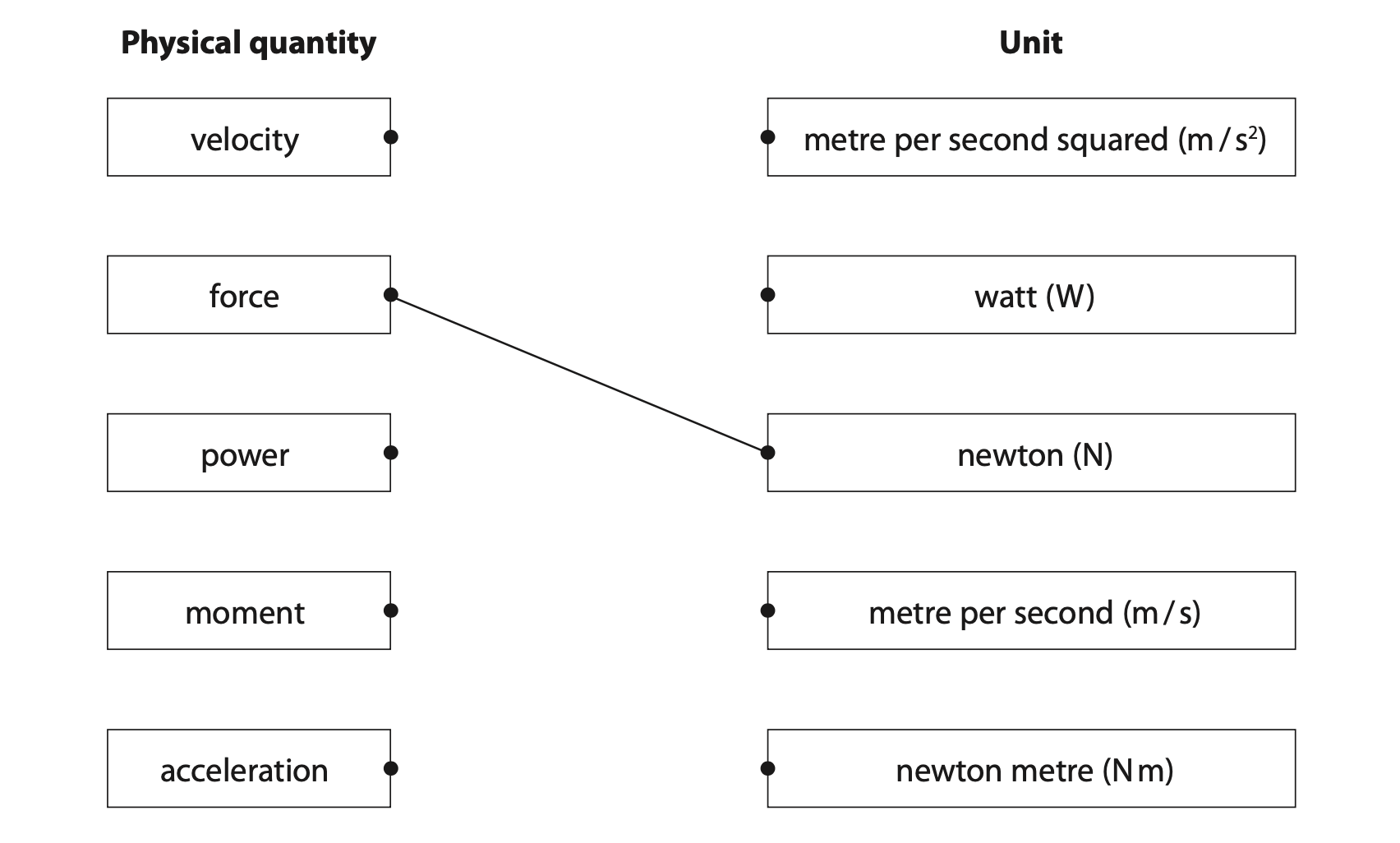
(b) Some physical quantities are scalars and other physical quantities are vectors.
(i) State the difference between a scalar quantity and a vector quantity. (1)
(ii) Give an example of a scalar quantity. (1)
(Total for Question 1 = 5 marks)
June 2023 Paper 2PR Q4
4 The photograph shows a dummy during a test of the safety features of a car in a collision.
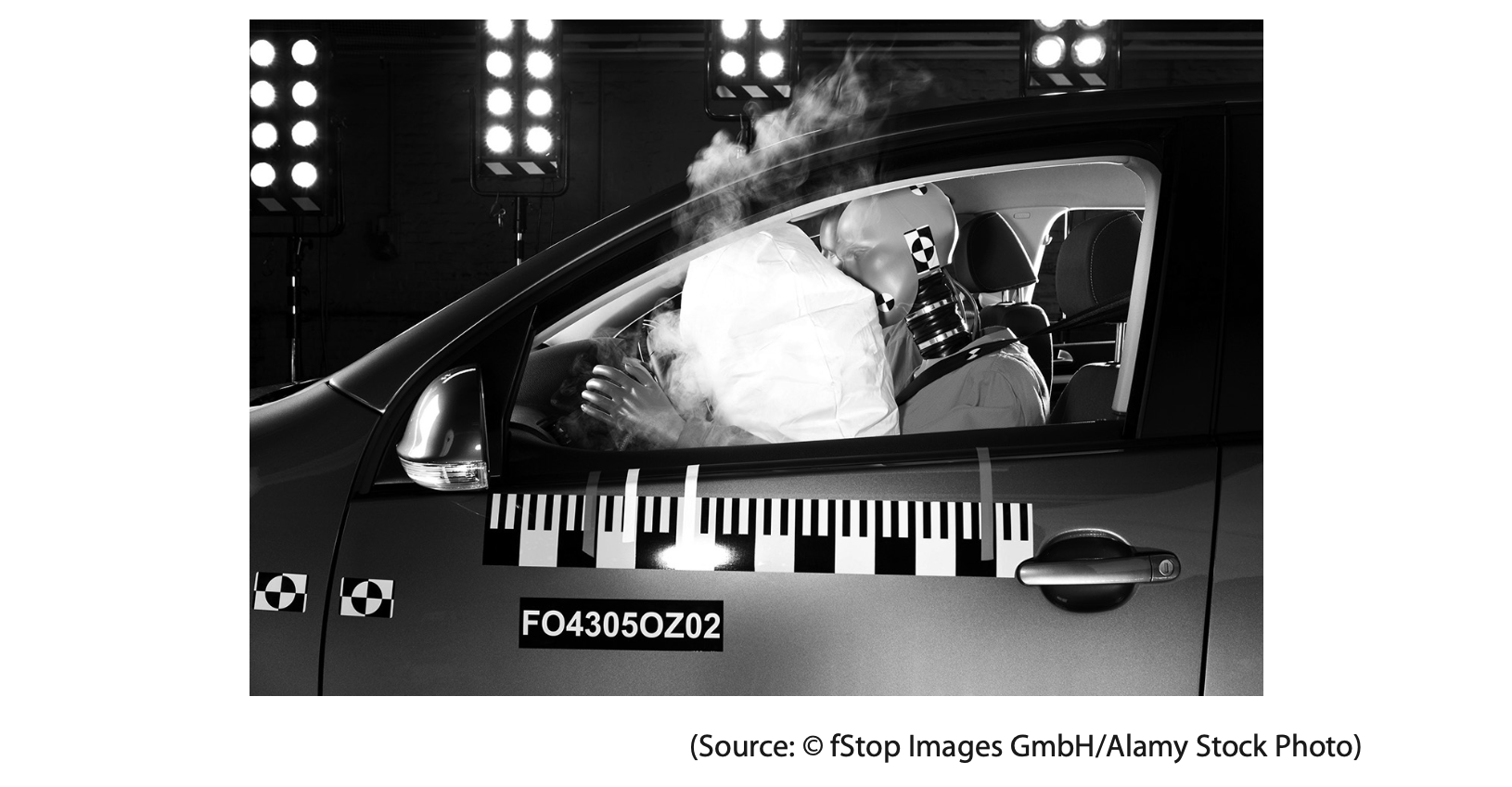
Before the collision, the dummy in the car is travelling at a velocity of 14 m / s.
The dummy has a momentum of 1100 kg m / s.
(a) (i) State the formula linking momentum, mass and velocity. (1)
(ii) Show that the mass of the dummy is approximately 80 kg. (3)
(b) The dummy is brought to rest during the collision by a mean force of 15 kN.
Calculate the time taken for the dummy to be brought to rest in the collision. (3)
time taken = …………………………………………………….. s
(c) The car being tested is fitted with airbags.
Using ideas about momentum, explain how an airbag reduces the force experienced by the dummy in the collision. (2)
(Total for Question 4 = 9 marks)
November 2023 Paper 1P Q6
6 (a) The graph shows how the velocity of a ball rolling down a long ramp changes with time.
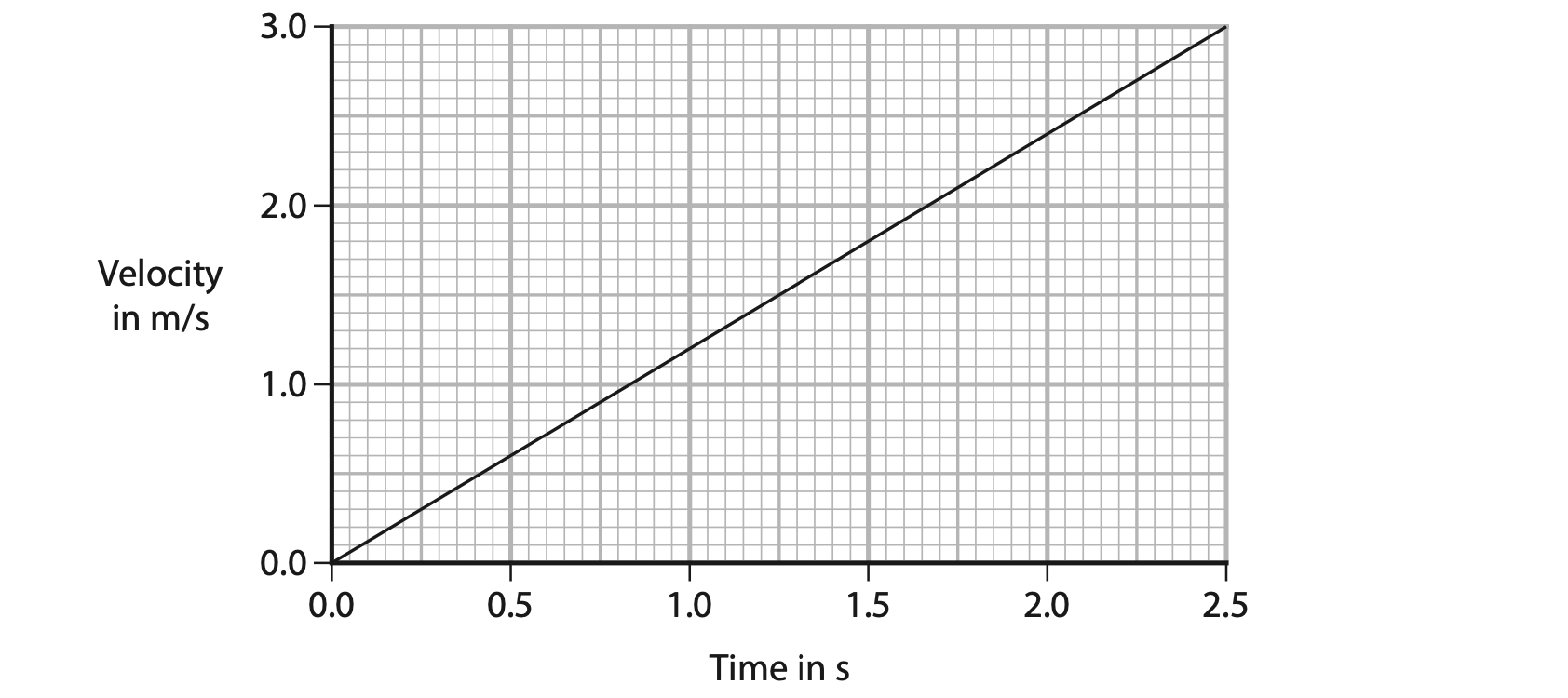
(i) Using the graph, calculate the acceleration of the ball. (3)
acceleration = …………………………………………………….. m/s2
(ii) State the feature of the graph that gives the distance travelled by the ball. (1)
(iii) Calculate the distance travelled by the ball in 2.5 seconds. (3)
distance = …………………………………………………….. m
(b) The table shows data for the ball after it has travelled for two different times.
| Time in s | Distance in m |
| 5.0 | 15 |
| 10.0 | 60 |
A student suggests that these results obey the relationship:

Use data from the table to deduce whether the results support this suggestion. (3)
(Total for Question 6 = 10 marks)
November 2023 Paper 2P Q2
2 This question is about moments.
Diagram 1 shows the raised lower leg of a person.
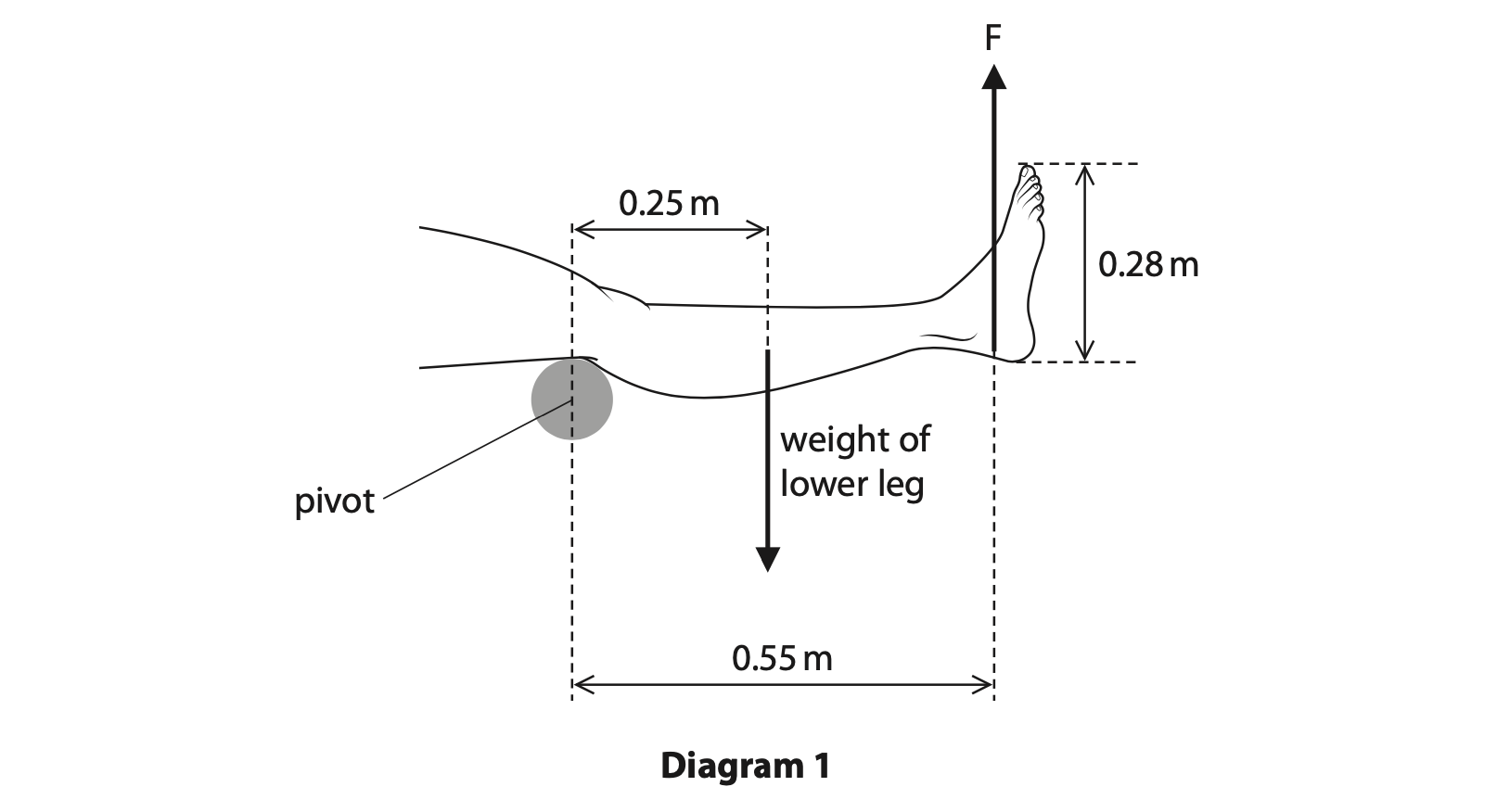
(a) (i) The moment of the weight of the lower leg about the pivot is 19 N m.
A vertical force, F, is applied to the person’s foot to keep the lower leg raised.
The lower leg does not move.
Calculate the magnitude of force F, using the formula (2)
moment = force × perpendicular distance from pivot
force F = …………………………………………………….. N
(ii) Which distance is used to calculate the moment of the weight of the lower leg about the pivot? (1)
A 0.25m
B 0.28m
C 0.30m
D 0.55m
(b) Diagram 2 shows the person resting their lower leg on two supports.
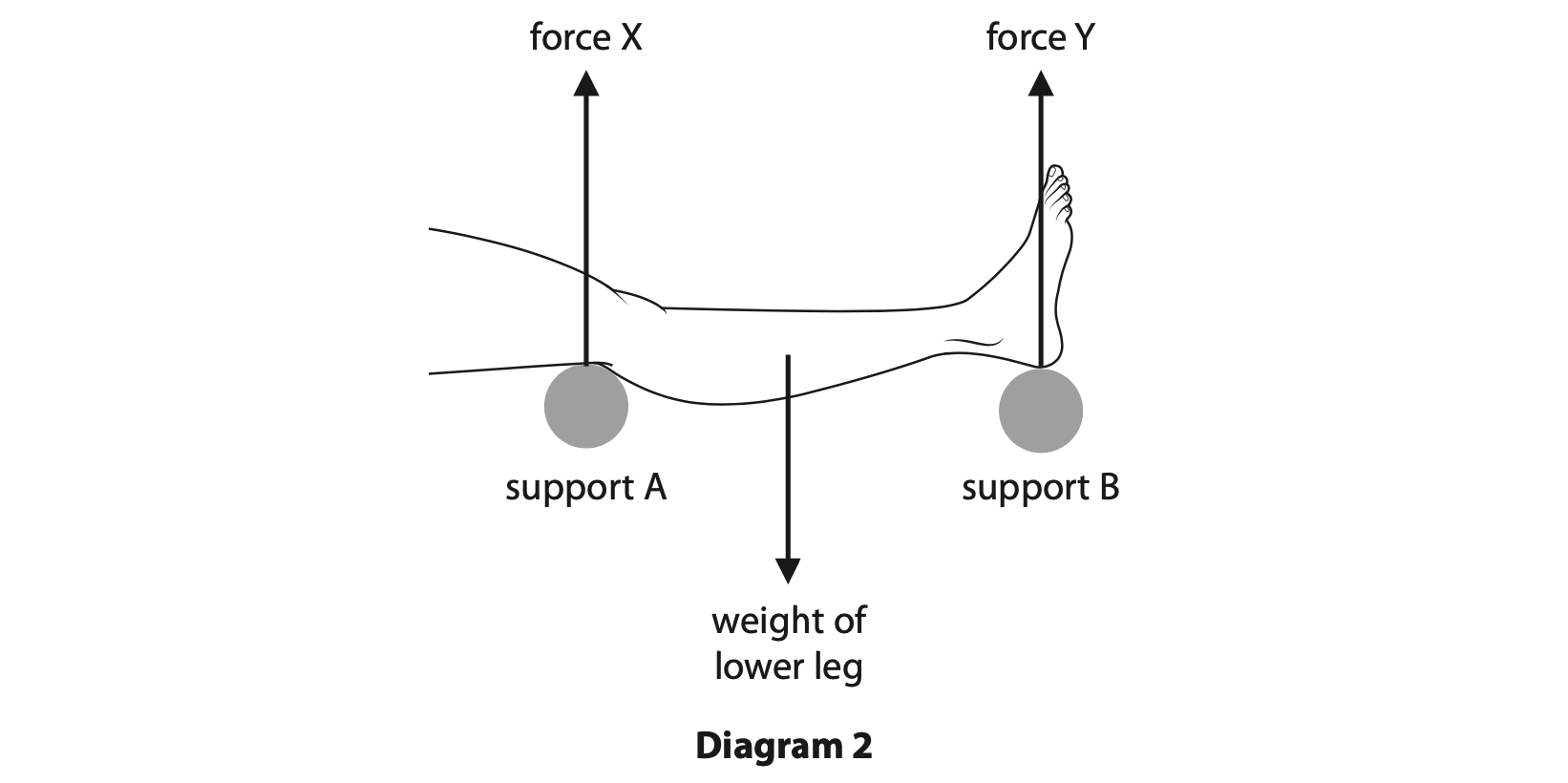
(i) The centre of gravity of the lower leg is 0.25 m away from support A and 0.35 m away from support B.
Explain whether force X or force Y is larger.
Ignore the weight of the upper leg. (3)
(ii) A bag of ice is placed on the lower leg, vertically above the centre of gravity.
This causes force X and force Y to increase.
The bag is then moved towards the person’s foot.
Describe how force X and force Y change as the bag is moved towards the person’s foot. (3)
(Total for Question 2 = 9 marks)
November 2023 Paper 2P Q6
6 This question is about momentum and forces.
(a) State the principle of conservation of momentum. (1)
(b) The diagram shows an air track that can be used to investigate motion without friction.
Air comes out through a series of small holes in the air track. The air lifts the glider slightly above the track.
A small spacecraft engine floats at rest on a cushion of air.

(i) State the momentum of the spacecraft engine when it is at rest. (1)
momentum = …………………………………………………….. kg m/s
(ii) The spacecraft engine ejects large numbers of xenon ions to the left.
A mass of 2.6 × 10−8 kg of xenon ions leaves the engine with a mean speed of 26km/s.
Calculate the momentum of all the ejected xenon ions. (3)
momentum = …………………………………………………….. kgm/s
(iii) State the magnitude and direction of the spacecraft engine’s momentum after these xenon ions leave the engine. (2)
magnitude of momentum = …………………………………………………….. kg m/s
direction of momentum = …………………………………………………….
(iv) The ions exert a force of 2.6 mN on the spacecraft engine.
The spacecraft engine has a mass of 1.2 kg.
Calculate the acceleration of the engine.
Give your answer to 2 significant figures. (4)
acceleration = …………………………………………………….. m/s2
(c) The engine is designed to accelerate a spacecraft while the spacecraft is travelling through space.
The spacecraft carries a mass of 0.75 kg of xenon ions for the engine.
When the engine is used, 9.9 × 10−8 kg of xenon ions leave the engine each second.
A student suggests that this small spacecraft engine would not be useful because the acceleration it produces is very small.
Evaluate the student’s suggestion. (2)
(Total for Question 6 = 13 marks)









